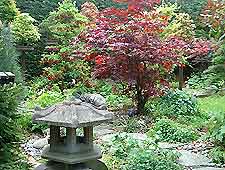Bonsai Trees
Pests

A severe outbreak of pests or disease can be incredibly damaging for a bonsai tree. They are unable to outgrow infestations and as a result extensive die back and even death of the tree can occur. However, being fairly small and manageable, bonsai are usually easy to treat.
Healthy, strong trees are often most resistant, but all trees should be regularly inspected so that any problems can be eradicated quickly, before they become serious and damaging.
Treatments
Pests can be treated either chemically or organically and both methods can be extremely effective. When mixing insecticide solutions, always follow the manufacturer's instructions exactly. Too weak a solution and the insects will remain, too strong and the foliage may be damaged.
If in any doubt, test on a small back branch first. Most pests can be eliminated by using systemic insecticides, which are absorbed directly into the plant's system. Always treat chemicals with respect and spray in dull, still, dry conditions, away from pets and garden ponds. Simply keeping your bonsai on stands off the ground helps prevent attacks of wood lice and also stops garden worms entering the soil.
Some common pests and suggested treatments follow:
Aphids (including greenfly and blackfly)
Bonsai Symptoms: Buds and shoots appear deformed and curled. A sticky sugary substance known as 'honeydew' appears, attracting ants and causing unsightly sooty mould.
Chemical Solutions: Most systemic insecticides are suitable. Alternatively, try 'plant pins', which when pushed into the soil are absorbed into the tree's system, preventing the need for spraying. Root aphids should also be sprayed with systemic insecticides if apparent when repotting.
Organic Solutions: Wash off with water spray (aphids do not climb back) and control with special soft soap sprays. Sprinkle lacewing larvae over the tree from mid-spring onwards (average temperature 10°C). 1 larva eats over 300 aphids. Also encourage ladybirds by not using insecticides in the garden.
Red Spider Mite
Bonsai Symptoms: Mottling of the foliage, which turns from yellow to brown and then falls. Conifers are most often attacked.
Chemical Solutions: Systemic insecticides.
Organic Solutions: Control with a solution of organic soft soap, spraying under the leaves. When temperature is above 16°C, 'phytoseiulus', a tiny harmless mite, can be tapped over infected plants. Increase levels of humidity around tree.
Scale Insect
Bonsai Symptoms: Yellowing and wilting of the leaves. Look for small limpet-like shells, often with white fluffy undersides, may be visible on the trunk, branches and leaves.
Chemical Solutions: Systemic insecticides. For small outbreak, paint shells directly with alcohol, such as methylated spirits.
Organic Solutions: Pick off by hand. When temperature is above 14°C, 'steinernema' nematodes can be applied.
Caterpillars
Bonsai Symptoms: Foliage is eaten and caterpillars are usually visible. Act quickly if several caterpillars are present!
Chemical Solutions: Contact or systemic insecticides.
Organic Solutions: Use organic spray 'Di-Pel' which leaves no harmful residues - or simply remove by hand.
Vine Weevil
Bonsai Symptoms: Larvae eat and destroy root system. When tree starts wilting the problem is usually very serious. Adults often leave u-shaped holes in leaves.
Chemical Solutions: Prevention is the best way to control this 'evil weevil'. Mix specific soil insecticides into the soil when repotting or water soil with vine weevil insecticide containing lmidachlopid. Both treatments last for six months.
Organic Solutions: Prevent infestation by applying barrier glue to bonsai bench legs to protect plants from climbing weevils. Apply heterohabditis nematodes in late spring and in early autumn (use soil thermometer to check that soil temperature is at least 12°C).
 A severe outbreak of pests or disease can be incredibly damaging for a bonsai tree. They are unable to outgrow infestations and as a result extensive die back and even death of the tree can occur. However, being fairly small and manageable, bonsai are usually easy to treat.
A severe outbreak of pests or disease can be incredibly damaging for a bonsai tree. They are unable to outgrow infestations and as a result extensive die back and even death of the tree can occur. However, being fairly small and manageable, bonsai are usually easy to treat.